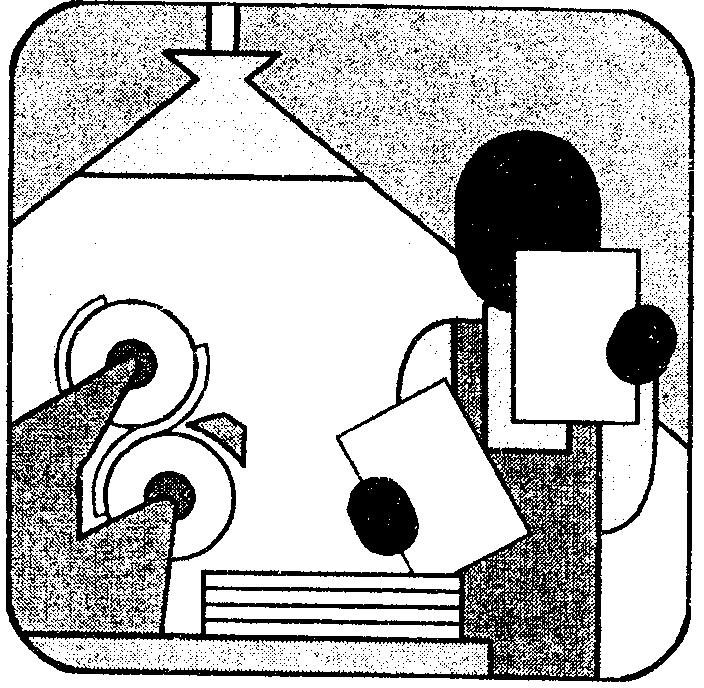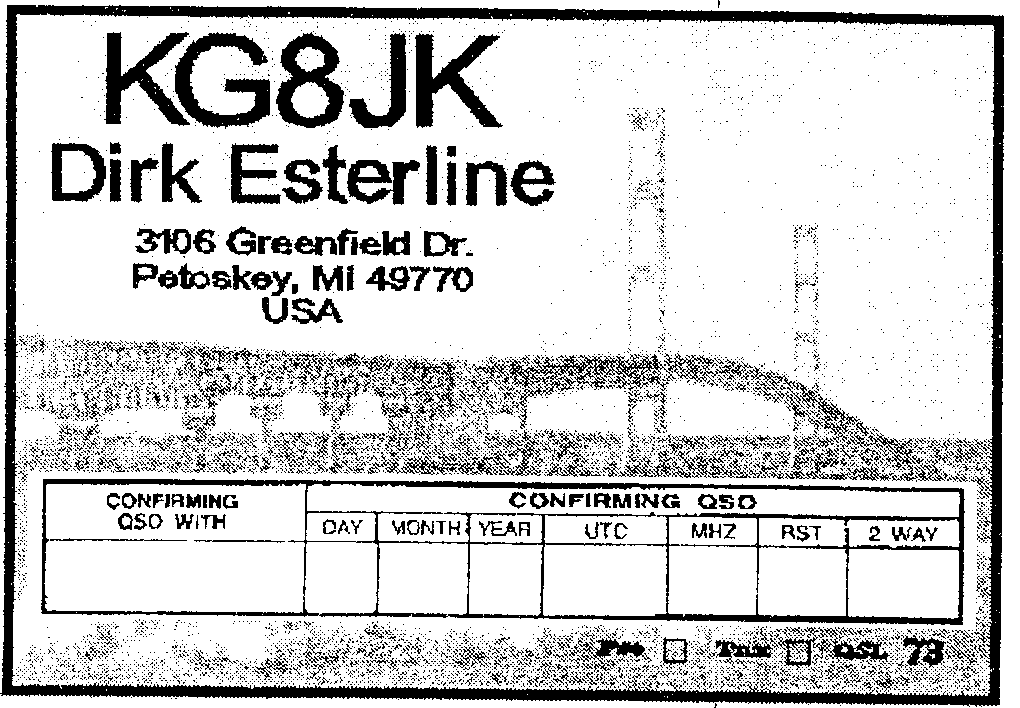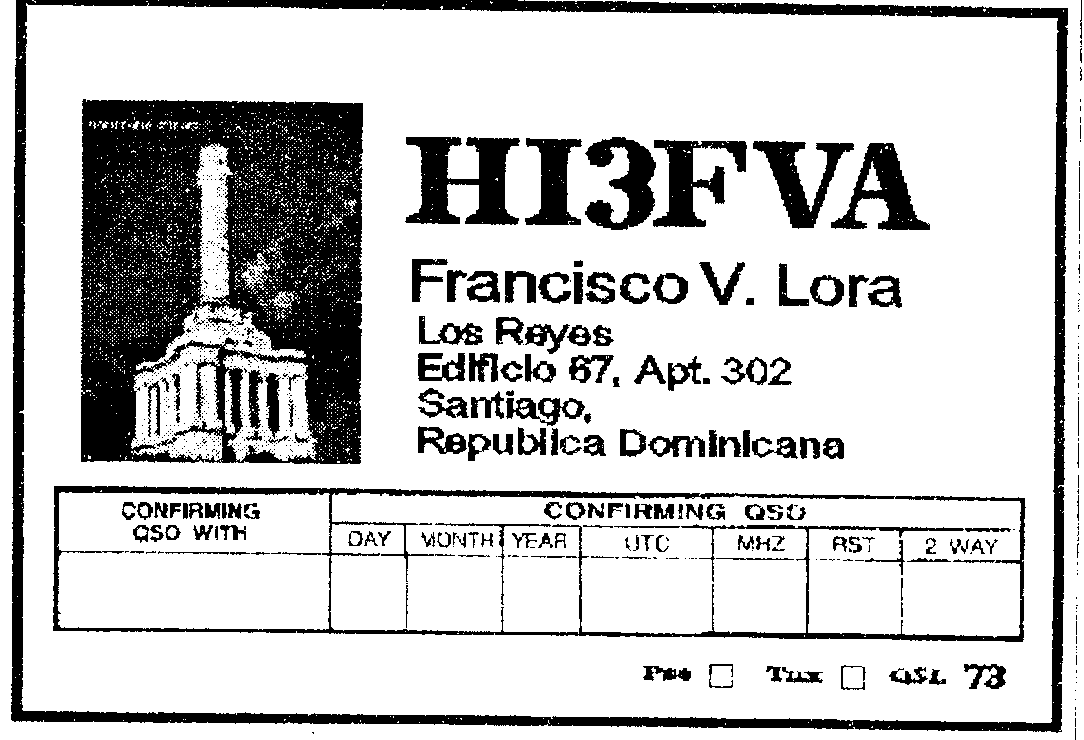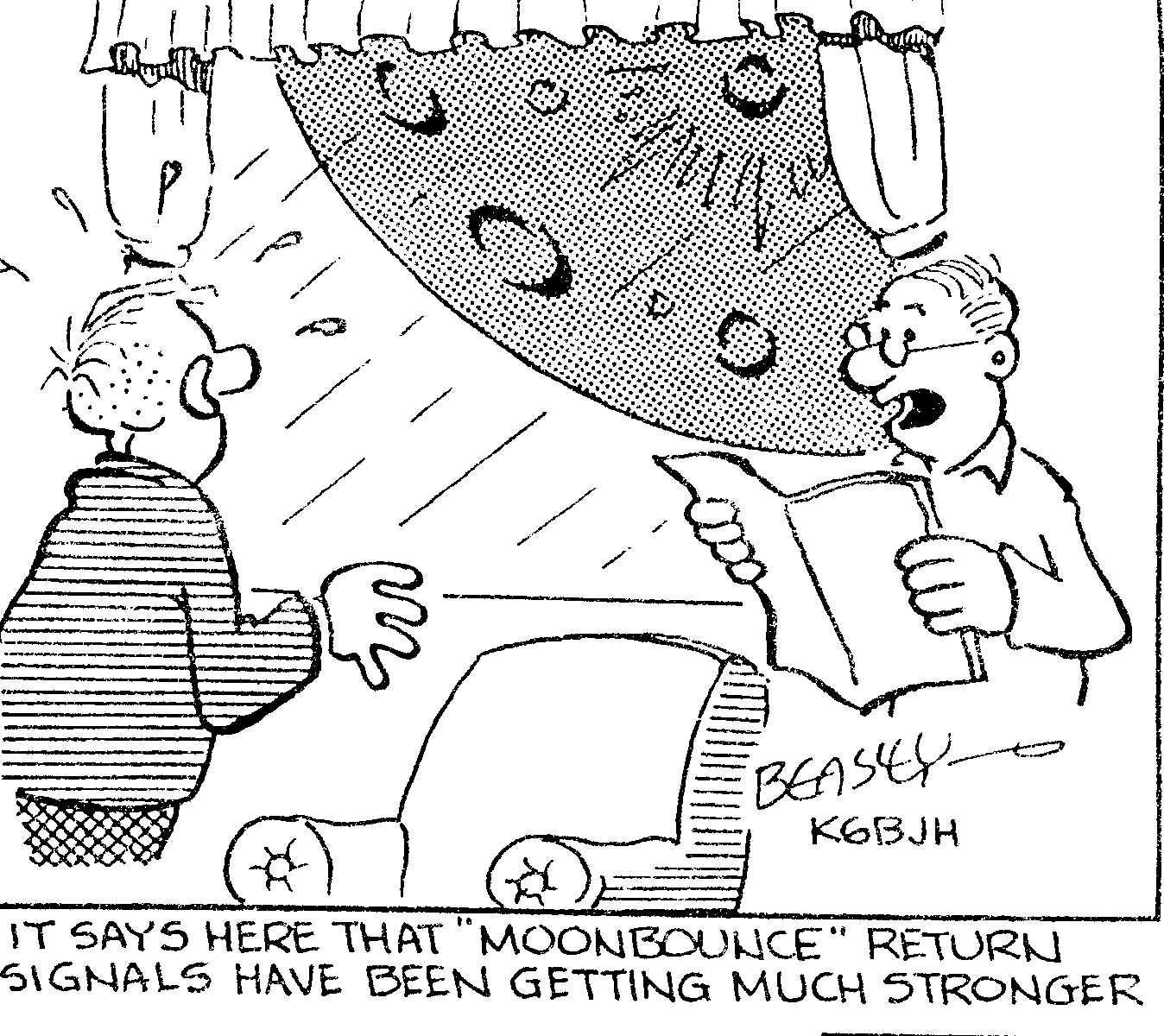
By
Mitch Stern, W1SJ
By Mirtch, W1SJ, Vermont Technical Coordinator. This appeared in the July 1999 (electronic) issue of The Monitor, the newsletter of the Twin State RC, Mike Maynard, WB1GRR Editor.
The transistor is an amazing device which is the basis of virtually all electronics today. All transistors contain junctions which are very much like diodes. Diodes are renowned for their ability to mix RF signals. When two signals are mixed, the result is the two original signals, plus their sum and their difference. The general term we use for undesired mixing is intermodulation, or IMD, for short.
Here is an example which anyone in the North Burlington area can observe. During the day, when you tune to 770 kHz on the AM broadcast band, you hear what appears to be two stations on top of each other. The two stations are WVMT on 620 kHz and WKDR on 1390 kHz; both located nearby and very strong. A diode junction somewhere in the receiver will mix the two signals and produce their difference (1390 – 620 = 770 kllz). If your radio would tune up the band, you would also pick up their sum (1390+620=2010 kHz). Anytime you have two or more strong signals and a junction of a transistor or anything which behaves like a diode, you will have mixing!
Not all mixing is bad. Mixing signals forms the basis of the superheterodyne receiver and many types of transmitters. When you tune a receiver, you are actually changing the frequency of a miniature transmitter! This transmitter is mixed against the signal which you want to hear to form another frequency. Let's say you wanted to receive a station on 99.9 MHz. A typical FM receiver would have you tuning a small transmitter to 110.6 MHz. The result of the mix is four signals: 99.9, 110.6, 210.5 (sum) and 10.7 (difference). Following this mixer is a bandpass filter which will only let the 10.7 MHz signal through
and which will stop the other 3 frequencies. For any stationyou want to hear, you tune the receiver (actually transmitter) 10.7 MHz lower and any station you pick up is converted to 10.7 MHz, which is aptly called the intermediate frequency. Don't believe it? Get two FM radios and tune one to around 107.7 MHz. Hold the second receiver nearby and tune it around 98 MHz.
You should be able to dump a carrier on 107 MHz. There is a sticker on all FM radios that says they comply with FCC Part 15 (low power) regulations. Airlines freak out over use of FM receivers because the little transmitters in them dump right smack on the aircraft band!
Unfortunately, mixing can be a real pain for those who try to make receivers work. At repeater sites, there are often many transmitters with strong signals and ALL these signals will mix. Anyone who designs a system must use computer modeling to calculate all possible mixes (hundreds) from the available transmitters. Sometimes, it is the subtle, unpredicted mixes that get you. A UHF repeater I had was plagued with low-level interference whenever the transmitter came on. I was astonished to find that a 2-watt UHF transmitter in the building mixed with the 1 mW, 12 MHz crystal oscillator, thus dumping a weak carrier right on the input of the repeater.
The solution was elegant - I took the cover off the transmitter and the problem went away. That worked for years until a mouse decided to use the transmitter for his personal toilet, and, to make a long story short, liquids coming from a mouse are highly corrosive on circuit boards! If mixing two fundamental signals produce four signals, then mixing three signals will produce even more signals. If the three signals are a, b and c, then the outputs are a, b, c, a+b+c, a+b-c, and a-b+c. A classic example of a 3-signal mix is found in Burlington at Fanny Allen Hospital. Thc mix involves the .61 repeater, and two pagers on 152.48 and 152.24 Mltz. The math is 146.61+152.48-152.24=146.85. As predicted, when all three transmitters are on, the 146.85 repeater from Essex is obliterated anywhere in the vicinity.
It gets worse! Not only must the original signals be considered, but also their 2nd, 3rd and 4th harmonics. Now the mixing possibilities abound. Years ago, there was a second receiver for the 146.85 repeater situated 600 kHz above the output on 147.45 MHz.
When the broadcast station moved frequency a few years ago, this frequency became unusable. Why? The second harmonic of the station mixed with a pager (2x95.5-43.56=147.44). At a site with several transmitters it is easy to amass hundreds of frequencies with interference due to intermodulation.
Mixing can take place in receivers, transmitters, antennas and virtually anything which forms an electrical diode. Corroded connections are notorious for forming diodes. For years, I had a problem on 160M and 8OM, in which I would receive mixes from various radio stations, causing interference across the bands. The 3rd harmonic of WVMT (620 kHz) was especially nasty, usually pinning the S-meter on 1860 kHz, although it vanished as one moved away from my QTH. The problem would come and go, depending on weather and my transmitter power. After months of detective work. the problem was traced to my antenna! The connections from the coax to the dipole were corroded enough to form a diode! Cleaning and re-tightening the connectors fixed the problem. I suspect many of the nasty little noises on the 145.15 repeater are due to a diode forming somewhere near the antenna - probably due to corroding hardware.
How do you get rid of unwanted mixes? It takes a ton of work to find them and to eliminate them. First, seek out and destroy all unwanted diodes by looking for corrosion anywhere near an antenna system. Be suspicions of any metal - even rain gutters! Make sure all transmitters you use employ built-in harmonic filters. Finally, when you understand the dynamics of the mixing, obtain sharp cavity filters to either pass or notch out the appropriate frequencies. The details of how this is done is usually best left up to the experts - and they get stumped a lot!
KN
Making Your Own QSL Cards
By Dirk Easterline, KG8JK, Editor of "The STATIC" the newsletter of the Straits Area ARC. You can check out the SAARC web site at
http://www.ncmc.cc.mi.us/dirk/news.htmOne of the most enjoyable parts of Amateur Radio is sending and receiving QSL cards. The excitement of breaking through the pileup and working that rare dx is relived the day the card comes in the mail. Most hams display their cards proudly like a big game hunter does with his trophies and behind each one is the story of the hunt.
The down side of qsling is the cost. One look in the back of any Ham magazine and you will see what I mean. You can find some good deals if you look but the cards will be in black ink and have some impersonal design that says nothing about yourself. To get the really good deals you have to buy 1000 cards! After changing calls three times I would probably have 1500 useless cards laying around the shack. They work great as scratch pads and coasters. You could even make a couple of decks of playing cards out of them if you like.
There are many alternatives to buying premade QSL cards. Making your own card gives you the flexibility to make a card that is truly personalized and that you can change at will. You only need make the amount that you will use an when you run out you won't have to wait for weeks for a new batch to arrive.
The simplest solution to the QSL dilemma is the postcard. If you live in a tourist area it will be easy to find a card. Here in Petoskey, MI you can find cards with pictures of Lake Michigan and the historic Gaslight District of downtown. At four for a dollar you can mix and match the cards that you like. The pictures are usually of very high quality. My favorite is a picture of a Petoskey Stone in the shape of Michigan sitting on a piece of quartz. Many computer logging programs have an option for making labels that you can just stick on the back of the card. With a computer and a little experimentation you can make your own confirmation grid for filling in the pertinent information. If you don't own a computer you can have a rubber stamp made up at your local print shop with your call and a grid. Hey, nobody says you can't just fill in the information by hand. Try writing it like a letter..."Thanks for the QSO last night on 20 meters...your 59 signal was booming into Michigan."
If you own a computer you can make your own cards from scratch. Programs such as "Print Artist" and "The Print Shop" have options for making postcards. I purchase 8.5 X 11 cardstock at 5 cents a sheet and can fit four cards onto each sheet. If you send lots of domestic QSLs, why not purchase postcards from the postoffice. They already have the postage on them and the cardstock is free! You can download images from the internet or take a picture of your shack and scan it. (Don't buy your own. Use your friend's scanner). I scanned the QSL grid off one of the cards I received and saved it as a bitmap file and use that on my cars.

KN


QRP Notes: Light Emitting Diodes
This appeared in the June 1999 issue of "KEY-KLIX" the newsletter of the Santa Barbara ARC by Jim Henry, KE6WGO.
QRP operation and low power lights are a natural combination. Imagine a lamp that uses 1/10th the power that a normal incandescent lamp uses, while still providing useable light. I say 'useable' because the color may not be white, and the intensity may be lower, but it works well, as I found out while camping with my family.
Last summer Don Klipstein wrote: "The HLMP-DD16 is an amazing, very slightly orangish red LED lamp with an overall Iuminous efficacy ranging from 19 to 23 lumens per watt according to my tests. The conversion efficiency is the best I have seen of any bright LED's- varying from 13 to 16 percent. This is a 5 mm (T1-3/4) lamp. Rated brightness is 3.6 candela and the nominal beam diameter is 15 degrees. Peak wavelength is 639nm and the dominant wavelength is 630 nm according to the datasheet,"
You can experiment using a similar, readily available 'Orange Jumbo High Brightness' LED from Radio Shack (276-206). While a bit pricey at $3.99 each, the 12000 mcd part does a good job, and the savings in batteries will more than offset your initial cost and effort. Here's what I did to package this LED for my 2 AA cell (3V) flashlight:
1. Make sure the plastic LED housing is about the same size as the glass bulb of the existing lamp so it will fit into your flashlight.
2. Take a flashlight lamp and carefully remove the glass with a pair of needle nose pliers. CAUTION: wear eye protection. You may collect the glass slivers by crushing the bulb inside a paper bag.
3. De-solder the wire from the bottom of the bulb and remove enough solder to open a hole in the bottom of' the metal socket.
4. Clip the longest (+) lead of the LED just long enough to carefully solder a 27-ohm resistor close to the bottom of the LED so it will fit inside the metal socket.
5. Bend the remaining (-) lead to fit into the notch on the side of the socket, and fold it down so it may be soldered on the outside.
6. Insert the LED and resistor assembly into the socket and solder.
The 27-ohm resistor was selected to work with both alkaline and NiCad batteries for the nominal 1.9 Volt forward voltage drop of this part. You will get about eight times the battery life with this LED lamp compared to the original. The LED itself will probably last longer than the flashlight housing it.
This red-orange light will also help preserve your night vision, making other ambient light more effective. You won't get the tunnel vision and momentary 'blinding' experienced with an intense white beam. Mariners and astronomers have known this for many years. Red LED flashlights are a popular accessory astronomers use while adjusting their equipment.
Combinations of red, green, and blue LED's can produce "white" light Some manufacturers use a blue LED with phosphors like those in fluorescent lamps to produce a white LED.
Narrow beam angles make reflectors unnecessary. Large arrays of LED's' provide bright, reliable illumination for stop lights. The efficiency of these devices greatly reduces requirements for solar powered applications.
Whiterook Products [http://vww. electronicsusa.com (805)-339-0702] sells the MK-79ES QRP lamp with five yellow LED's running about 24 ma from a 12 V source. That's 50 hours continuous use on a 1.2 Ah battery. This model has an optional push-button and switch. The red housing is designed to sit on top of your rig illuminating the dial and logbook below. Considering current prices (and minimum order numbers) for the parts alone, it's a good value at $25.
For more information about efficient high brightness LED's see the following WWW page by Don Klipstein: http:// www.misty-com/ don/led.html
KN
GRUMMAN AMATEUR RADIO CLUB
MINUTES OF GENERAL MEETING 9/15/99
BY Pete, N2PYV
The meeting was called to order by Pat at 5:05 PM. All present introduced themselves.
TREASURER'S REPORT
Ted, KD2UB
Ted read the financial statement. Finances continue to be in good shape.
REPEATER REPORT
Gordon, KB2UB
There are reports of jamming on the Hauppauge Repeater. Someone was playing tapes of previous QSO's by K2DKR.
WAG
No activity
VE REPORT
Bob, W2ILP
No applicants showed for the last session. Bob reported that FCC restructuring should occur before the end of the year. They are considering the future of amateur radio.
WAG REPORT
Bob, W2FPF
No activity reported.
HOUSE REPORT
Pat reported that maintenance on the outside of the shack has been completed, but no repairs were done inside. The Ten Tec transceiver has been removed from the shack to be shipped out for repairs.
NEW BUSINESS
Dave, AB2EF, has volunteered to reproduce copies of the Northrop Grumman video tape "Man on the Moon, The first manned Lunar Landing, a Look Back". You provide the tape and $2.00, which will go to the club treasury.
Zak, WB2PUE, reported that the Thursday night 2-meter net was poorly attended with only four check-ins. The southern contacts on the HF net were talking about the oncoming hurricane.
Pat reported that there was a photo of Pat, Dave and Gordon working the radio for the special event station commemorating the first manned landing on the moon in a Grumman Lunar Module in the ISA Newsbriefs, published by Northrop Grumman.
Pat reported that we were dropping names of those who had not paid dues from the mailing list.
Pat announced that the executive board is considering setting up a new place and time for the general meetings so that those who work will be able to attend. The proposed place and time is the Underwriters Lab in Melville, just north of the expressway, at 7:30PM. If this proposal is implemented, it will start with the January meeting. There will be further announcements about this.
Marty stated that the commemorative QSL card is in the printer.
PROGRAM
Marty gave a discussion about the "Ham Radio University 2000" which is being planned for January 23, 2000. Several of the amateur radio clubs on Long Island are getting together to put this on. There will be forums on many aspects of ham radio.
EDITORIAL
Being a Member of the Club
This appeared in the May 1999 issue of. "Waves", the newsletter of the Chattanooga ARC Charles Curle, AD4F Editor. By Rick McCusker, KO6DJ, Editor "WorldRadio Magazine" and January 1999 "The Atlanta Ham", John Talilpsky, KI4Y Editor.
When someone becomes a member of a club, there are several reasons for joining. Usually, the new member has an interest in what the club is doing and wants to be a part of tile "action." Some become members of a club because they want to associate with others with a like interest, be it hobby or employment related.
When someone joins a club, he or she should also realize the responsibilities they have assumed when they join. Each member is expected to contribute to the club in a positive fashion. A member can contribute by volunteering for an office, the Board of Directors, or as the leader of a special project the club has in mind. One can also contribute by assisting any of the elected officers or by serving on a committee.

Newsletters are an excellent way to get information and interesting subjects to the members. Your contribution can be about what interests you have in Amateur Radio. Have you ever had an interesting experience in Amateur Radio? Why not write about it for the newsletter? Others may be interested in hearing about it. Has anything ever happened to you that was down right embarrassing at the time, but is hilarious now? Others would like to read about it. Do you have a passion for a certain area of the Amateur radio hobby? Others may share that passion, and you don't even know it!
One thing that stops members from contributing a story or article for a newsletter is, "I can't write!" Oh ye of little faith! That's why Editors were created! Sure, some of us can sit down and whip out a 1500 word story in nothing flat while the majority sit and stare at the screen for hours on end. You don't have to be a Hemingway or Clancy to contribute. Editors love to turn over papers and shake out the commas! We can fix anything!
So, what are you waiting for? Write that story! Your club members want to hear it.
KN